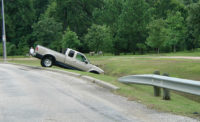To better understand when hearing protection is required and what actually constitutes overprotection, it is important first to have a working knowledge of how sound waves are actually measured.
How is sound measured?
Sound energy travels in waves and is measured in frequency and amplitude. Frequency can be gauged by the number of sound vibrations in one second. A person with normal hearing can perceive sounds from a very low frequency, 20 Hertz (or 20 cycles per second), to a very high frequency of 20,000 Hertz. Amplitude measures the force of the wave in decibels or dBA of sound pressure. For example, the softest sound a person can hear is at 0 dBA; normal speech is around 65 dBA; and a jackhammer is roughly 125 dBA. The more pressure a sound has, the less time it takes to cause damage. Unprotected hearing at sustained noise levels between 90-95 dB can cause permanent hearing loss. But even short-term exposure at 140 dB with hearing protection could cause such damage.
Assessing noise hazards
Understanding the noise level of hazards in the work environment is critical to determine the level of hearing protection necessary. Protection is needed when sounds are 85 dBA or above because, at this level, a person’s hearing can be permanently damaged. Each protective device is marked with a Noise Reduction Rating (NRR) level which explains the level of attenuation. The noise level should be lowered to a level of 85 dB; anything lower is considered overprotecting.
Noise Reduction Rating
NRR describes the average sound level reduction (“attenuation”) provided by hearing protectors in a laboratory setting.
Estimating hearing protector attenuation
1. 8-hour Time Weighted Exposure (TWA) = 94 dBA
2. NRR of hearing protector = 31 dBA
3. Subtract 7 dB from the NRR = 31 dB – 7 dB is 24 dB
4. Reduce value by 50% = 12 dB
5. Subtract this value from the TWA = 82 dB (Estimated Protection)
6. Decide if the estimated protection works for your environment
Hearing conservation program
To ensure proper protection, those wearing hearing protectors for occupational exposures must be enrolled in a worksite hearing conservation program. According to OSHA, “an effective hearing conservation program can prevent hearing loss, improve employee morale and a general feeling of well-being, increase quality of production, and reduce the incidence of stress-related disease.”
The employer must administer a continuing, effective hearing conservation program whenever employee noise exposures are at or above an eight hour time-weighted average (TWA) of 85 dBA or, equivalently, a dose of 50 percent. This is referred to as the action level.
Minimum Requirements of a Hearing Conservation Program include:
1. Monitoring Program
2. Audiometric Testing Program
3. Hearing Protection Devices
4. Employee Training and Education
5. Recordkeeping
To learn more, visit: https://www.osha.gov/dts/osta/otm/noise/hcp/
Hearing overprotection: Why is it a risk?
Workers who overprotect can be at peril. If a worker cannot hear warning signals on their worksite or communicate with fellow workers, the consequences can be disastrous. What’s more, when workers are not able to effectively hear or communicate, it can lead to feelings of isolation. This can lead to common mistakes that could put the worker or co-workers at risk.
Overprotection often leads to NO protection
In situations where communication amongst coworkers or hearing noise alerts and/or warning signals is necessary, overprotected workers will likely remove their hearing protection device (HPD) to perform these functions. But when removing their HPD for hearing purposes in hazardous environments, the user loses all sound exposure protection. If this behavior is prolonged, it can lead
to long-term hearing loss.
Tips for preventing overprotection
1. Know your noise levels. Clearly identify the areas of the facility or work environment where hearing protection is required. This can eliminate the need for protection where not warranted. Equally important, you should provide hearing protection that is ideally suited for a particular hazard; protection that is overrated for a specific hazard also contributes to overprotection. OSHA mandates a Hearing Protection Conservation Program in every facility. There are tools available to measure the noise levels and determine hazards.
2. Choose the correct hearing protection device (HPD). An HPD choice should be made to lower exposure to a safe level for the worker — but not below 85dBA.
3. Emphasize the risks. It is critical that employees understand the potential danger involved when not using proper hearing protection and should comprehend the long-term, irreversible effects of hearing damage.
Dual protection
When using both earplugs and a muff, it is important to understand that simply adding the NRR levels together will not provide a dual protection level. Rather, hearing protectors — when properly worn together — will add 4-5 dB to the higher of the two NRR levels. Also keep in mind that dual protection can isolate the wearer, so plugs and muffs should only be worn together where noise levels are extreme, e.g., where the 8-hour TWA exposure exceeds 100 decibels. In addition, it is recommended that workers who utilize both earplugs and muffs wear cordless earplugs to prevent compromising cup seal.
When it comes to hearing protection, it is important to ensure you have the proper hearing protection for your work environment — do not overprotect or underprotect. Evaluate the environment, understand the NRR rating and keep the protection at a safe level according to EPA regulations.





